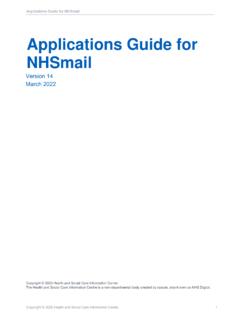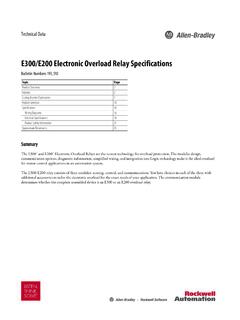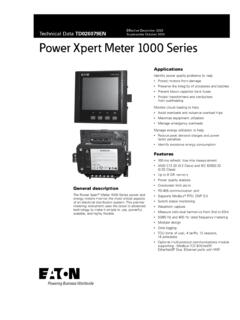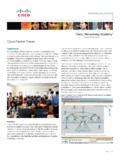Transcription of Basic Networking Concepts - UVic.ca
1 1 Basic Networking Concepts1. Introduction2. Protocols3. Protocol Layers4. Network Interconnection/Internet21. Introduction-A network can be defined as a group of computers and other devicesconnected in some ways so as to be able to exchange of the devices on the network can be thought of as a node; eachnode has a unique are numeric quantities that are easy for computers to workwith, but not for humans to : networks also provide names that humans can more easily remember than : , corresponding to the above addressConsists of 4 bytes separated by R first bytes (R= 1,2,3) correspond to the network address;-The remaining H bytes (H = 3,2,1) are used for the host Register: organization in charge of the allocation of theaddress ranges corresponding to considered: Geographical area (country) Organization, enterprise Department HostDomain Name System (DNS)-Mnemonic textual addresses are provided to facilitate the manipulationof internet addresses.
2 -DNS servers are responsible for translating mnemonic textual Internetaddresses into hard numeric Internet IP address identifies a host machine on the IP port will identify a specific application running on an Internet hostmachine. -A port is identified by a number, the port number. -The number of ports is not functionally limited, in contrast to serialcommunications where only 4 ports are are some port numbers which are dedicated for specific (e-mail)25 SMTP (e-mail)70 Gopher20 and 21 FTP80 HTTPPort numbersApplications5 Data Transmission-In modern networks, data are transferred using packet are broken into units called packets, and sent from onecomputer to the other. -At the destination, data are extracted from one or more packets andused to reconstruct the original packet has a maximum size, and consists of a header and a dataarea. -The header contains the addresses of the source and destination computers and sequencing information necessary to reassemblethe message at the data6 Types of NetworksThere are two principle kinds of networks: Wide Area Networks (WANs) and Local Area Networks (LANs).
3 WANs-Cover cities, countries, and on packet switchingtechnology-Examples of WAN technology: Asynchronous Transfer Mode (ATM),Integrated Services Digital Network (ISDN)LANs-Cover buildings or a set of closely related buildings. -Examples of LAN technology: Ethernet, Token Ring, and FibberDistributed Data Interconnect (FDDI). Ethernet LANs: based on a bus topology and broadcast communicationToken ring LANs:based on ring topologyFDDI LANs:use optical fibbers and an improved token ring mechanismbased on two rings flowing in opposite bus(a) Ethernet LANRing(b) Token Ring LANDual ring(c) FDDI LAN8 Network connectivity typeSpeedTransmission time for 10 Mbytes (Telephone) dial-up Kbps90 minISDN modem56/128 Kbps45/12minT1 Mbps50sEthernet10 Mbps9sToken ring4/16 MbpsFast Ethernet100 MbpsFDDI100 MbpsGigabit Ethernet1 GbpsATM25 of low capacity may be connected together via a backbonenetwork which is a network of high capacity such as a FDDI network, aWAN network etc.
4 -LANs and WANs can be interconnected via T1 or T3 digital leasedlines-According to the protocols involved, networks interconnection isachieved using one or several of the following devices: Bridge: a computer or device that links two similar LANs based on the same protocol. Router:a communication computer that connects different types ofnetworks using different protocols. B-router or Bridge/Router:a single device that combines both thefunctions of bridge and router. Gateway:a network device that connects two different systems, usingdirect and systematic translation between branchEthernet LANR outerVancouver branchToken Ring LANG atewayFrame Relay ATMT1 lineNY headquatersBridge/RouteToken Ring LANR outerBridgeBridge/RouterEthernet11 Network Topology DiagramThe specification of the network topology diagram requires the definition of the characteristics and entities underlying the network:-Geographical locations of the different components or subnetsinvolved in the of the LAN topology-Description of the WAN topology-Description of the network connectors such as routers, bridges,repeaters, and Protocols-Define the rules that govern the communications between twocomputers connected to the network.
5 -Roles: addressing and routing of messages, error detection andrecovery, sequence and flow controls etc. -A protocol specification consists of the syntax, which defines the kindsand formats of the messages exchanged, and the semantic, whichspecifies the action taken by each entity when specific events :HTTP protocol for communication between web browsersand : MAIL FROM: 250 OKS: RCPT TO: 250 OKS: DATAR: 354 Beginning of mail; ending by <CRLF>.<CRLF>S: Blah blah blahS: .. : <CRLF>.<CRLF>R: 250 OKRequest For Comments (RFC): specifications of the protocols involvedin Internet :sample of RFC 821 describing communications betweenSMTP server and layer(n-1)th layer(n-1)th are designed based on a layered architecture such as the OSIreference model. -Each entity at a layer ncommunicates only with entities at layer n-1. -The data exchanged, known as Protocol Data Unit (PDU), goes backand forth through the layers, each layer adds or removes its own headerand vice-versa.
6 Therefore a layer n PDU may become a layer Protocol LayersThe OSI (Open Systems Interconnection) Data Model-ISO standard for computer networks design and functioning. -Involves at least 7 layers, each playing a specific role whenapplications are communicating over the net. -During the sending process, each layer (from top to down) will adda specific header to the raw data. -At the reception, headers are eliminated conversely until the dataarrived to the receiving LayersPhysical layer(defines the physical characteristics of the network)Data-link layer(provides safe communication of data over the physical network)Network layer(handles connection to the network by the higher layers)Transport layer(provides end-to-end errors detection and correction)Session layer(manages sessions among applications)Presentation layer(provides standard data representations for applications)Application layer(applications connected to the network)17 Physical layer: ensures a safe and efficient travel of data; consists ofelectronic circuits for data transmission link layer: in charge of data encapsulation under the form ofpackets and their interpretation at the physical layer.
7 Network layer: in charge of packets transmission from a source A to adestination layer: in charge of the delivery of packets from a source Ato a destination B Session layer: in charge of the management of network layer: determines the format of the data transmitted toapplications, data compressing/decompressing, encrypting layer: contains the applications which are used by theend-user, such as Java, Word TCP/IP Model-Consists of only 4 layers: application, transport, internet and layer(applications and processes running on the network)Transport layer(provides end-to-end data delivery services)Internet layer(makes datagrams and handles data routing)Network layer(provides routines allowing access to the physical network)19 Network layer-Provides the same functionality as the physical, the data link andnetwork layers in the OSI between IP addresses and network physical of IP datagrams, packets, in format understandableby the layer-Lies at the heart of on the Internet Protocol (IP), which provides the frame fortransmitting data from place Ato place layer-Based on two main protocols: TCP (Transmission Control Protocol)and UDP (User Datagram protocol)Application layer-Combines the functions of the OSI application, presentation, andsession involved in this layer.
8 HTTP, FTP, SMTP Networks Interconnection/InternetConcept of Network Interconnection-First implemented in the Defense Advanced Research Project Agency Network (Arpanet), in 1966 in of connecting several computer networks based on differentprotocols-Requires the definition of a common interconnection protocol on topthe local protocols. -The Internet Protocol (IP)plays this role, by defining unique addressesfor a network and a host ring21P2P1P3P4IP22 Internet Protocol (IP)Overview-The IP protocol provides two main functionality: Decomposition of the initial information flow into packets of standardized size, and reassembling at the destination. Routing of a packet through successive networks, from the sourcemachine to the destination identified by its IP packets are not guaranteed to be delivered (datagram protocol).-The IP protocol does not request for connection (connectionless) before sending data and does not make any error detection.
9 Functions-Decompose the initial data (to be sent) into datagrams. -Each datagram will have a header including, the IP address and theport number of the are then sent to selected gateways, IP routers, connectedat the same time to the local network and to an IP service providernetwork. 23 SenderReceiverpacket1packet2 Routers-Datagrams are transferred from gateways to gateways until they arrivedat their final of an IP packet-The fields at the beginning of the packet, called the frame header,define the IP protocol s functionality and limitations. -32 bits are allocated for encoding source and destination addresses (32bits for each of these address fields). -The remainder of the header (16 bits) encodes various information suchas the total packet length in bytes. -Hence an IP packet can be a maximum of 64Kb 10 12 16 20 24 HeaderChecksumSource addressDestination addressOptionsData25 Transmission Control Protocol (TCP)Overview-TCP provides by using IP packets a Basic service that does guaranteesafe delivery: error detection safe data transmission assurance that data are received in the correct order-Before sending data, TCP requires that the computers communicatingestablish a connection (connection-oriented protocol).
10 ClientServerTCPSYNSYN_ACKACKDATADATAACKD ATAFINFINACK26-TCP provides support for sending and receiving arbitrary amounts ofdata as one big stream of byte data (IP is limited to 64Kb).-TCP does so by breaking up the data stream into separate IP packets. -Packets are numbered, and reassembled on arrival, using sequence andsequence acknowledge also improves the capability of IP by specifying port numbers. There are 65,536 different TCP ports (sockets) through which every TCP/IP machine can of a TCP packet0 2 4 8 12 20 Source portDestination portSequence Ack. headerData27 User Datagram Protocol (UDP)Overview-Datagram protocol also built on top of the same packet-size limit (64Kb) as IP, but allows for portnumber specification. -Provides also 65,536 different , every machine has two sets of 65,536 ports: one for TCP and theother for protocol, without any error detection facility.








